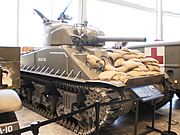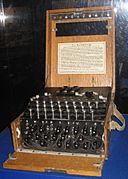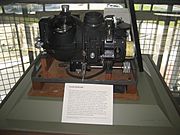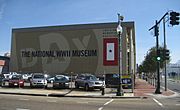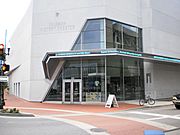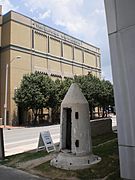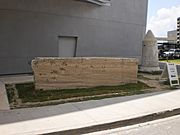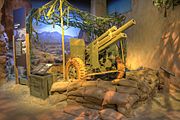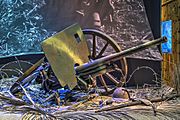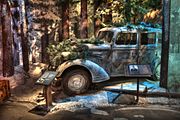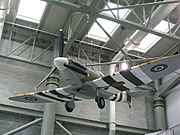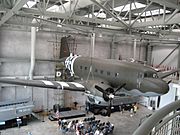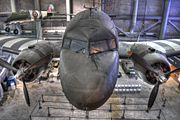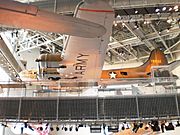The National WWII Museum facts for kids
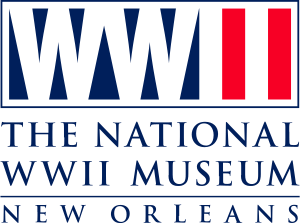 |
|

Main Entrance
|
|
| Former name | D-Day Museum |
|---|---|
| Established | June 6, 2000 |
| Location | New Orleans, Louisiana, U.S. |
| Type | Military history museum |
| Visitors | 706,664 (2017) |
The National WWII Museum, once known as The National D-Day Museum, is a special history museum in New Orleans, Louisiana. It teaches visitors about the United States' important role in helping the Allies win World War II. The museum opened in 2000. In 2004, the U.S. Congress officially named it America's National WWII Museum. It is also connected to the famous Smithsonian Institution, which helps share its stories with more people. The museum's main goal is to show what the American experience was like during World War II.
Contents
Learning About World War II History
The museum is partly located in an old brewery building. It first opened on June 6, 2000. This date was the 56th anniversary of D-Day, a very important day in the war. The first exhibits focused on the D-Day invasion of Normandy.
New Orleans was a perfect place for this museum. The special "Higgins boats," which were key for landing troops on beaches, were designed and built there. A famous historian named Stephen Ambrose also lived in New Orleans. He helped start the museum and wrote a book about D-Day.
Exploring the Museum's Exhibits
The museum has grown a lot since it first opened. It now has many different buildings and exhibits. These include the Solomon Victory Theater and the US Freedom Pavilion: The Boeing Center.
Louisiana Memorial Pavilion
In the main building, called the Louisiana Memorial Pavilion, you can see amazing aircraft. A Supermarine Spitfire and a Douglas C-47 Skytrain hang from the ceiling. A "Higgins boat" (LCVP) is also often on display. This pavilion shows how the war was fought in Europe. It also highlights what people did at home to support the war effort. You can also find temporary exhibits here. There's an interactive train car that lets you experience what it was like for soldiers going to war.
This part of the museum has permanent exhibits like "The Home Front" and "Planning for D-Day." On the third floor, you can get a closer look at the hanging airplanes.
US Freedom Pavilion: The Boeing Center
The US Freedom Pavilion: The Boeing Center opened in 2013. It is the largest building at the museum. Here, you can see many famous aircraft. These include a B-17E Flying Fortress bomber and a B-25J Mitchell bomber. There's also a SBD-3 Dauntless and a P-51D Mustang.
One special plane is the B-17E called My Gal Sal. It was lost over Greenland and found 53 years later! This pavilion also has an interactive submarine experience. It's based on the last mission of the USS Tang.
Campaigns of Courage Pavilion
In 2014, the "Road to Berlin" opened in the Campaigns of Courage pavilion. This part focuses on the war in Europe. You can see a Messerschmitt Bf 109 airplane hanging inside. The "Road to Tokyo" section, which opened in 2015, tells the story of the war in the Pacific.
Other Important Exhibits
In 2017, a new exhibit called The Arsenal of Democracy opened. It explores the experience of people on the home front.
The museum also has the Liberation Pavilion. This area explores the meaning of freedom and how World War II still affects us today. The museum is part of a network that helps protect art during wartime.
Interactive Dog Tag Experience
The museum uses interactive "dog tags" to make your visit more personal. When you enter, you get a dog tag that represents a real person from the war. As you go through exhibits like Road to Tokyo and Road to Berlin, you can use your dog tag on screens. This lets you learn about the specific journey of the person your dog tag represents.
Planning Your Visit
Visitors usually spend about 2.5 to 3 hours exploring the museum. When you arrive, you can board a simulated train ride. This ride shows what it was like for soldiers leaving for war. Your interactive dog tag helps you follow a specific person's story during this journey.
After the train ride, you can explore the museum at your own pace. The Solomon Victory Theater shows an award-winning 4-D movie called Beyond All Boundaries. It gives a great overview of the entire war. Many exhibits also include videos of veterans sharing their stories.
The museum has two restaurants: the American Sector Restaurant & Bar and the Soda Shop.
Fun Activities and Events
The museum hosts a wargaming club and an annual wargame convention called "Heat of Battle." There's also a yearly robotics challenge using Lego Mindstorms. The museum even has a World War II-themed quiz bowl tournament that is shown on TV.
The Museum's Connection to New Orleans
The museum had to close for three months after Hurricane Katrina hit New Orleans in 2005. It reopened in December of that year. A banner at the reopening said "We Have Returned." This phrase was made famous by General Douglas MacArthur when he returned to the Philippines during the war.
The museum has been expanding to add more exhibits and space. This expansion has helped more people visit each year. In 2010, about 400,000 people visited. By 2016, nearly 700,000 people came to the museum.
The museum is very important for the economy of Louisiana. It brings in about $132 million every year. It also provides many jobs, directly supporting 300 people and helping another 142 jobs.
Gallery
-
Enigma machine on display
-
Portion of the Atlantic Wall on the museum's campus
Airplanes
-
SBD Dauntless dive bomber
-
A C-47 on display in the museum atrium
-
detail of C-47
See also
 In Spanish: Museo Nacional de la Segunda Guerra Mundial para niños
In Spanish: Museo Nacional de la Segunda Guerra Mundial para niños
- American Heritage Museum – Stow, Massachusetts
- Imperial War Museum – London, England
- The International Museum of World War II – Natick, Massachusetts (closed in September 2019)
- Marine Corps War Memorial – Arlington County, Virginia
- Museum of La Coupole – German-built V-2 launch site in Pas-de-Calais, France
- Museum of the War of Chinese People's Resistance Against Japanese Aggression – Beijing, China
- Museum of the Great Patriotic War, Moscow – Poklonnaya Gora, Moscow, Russia
- Museum of the Second World War – Gdańsk, Poland
- National D-Day Memorial – Bedford, Virginia
- National Museum of the History of Ukraine in the Second World War – Kyiv, Ukraine
- National Museum of the Pacific War – in home of Fleet Admiral Chester Nimitz in Fredericksburg, Texas
- National World War I Museum and Memorial – Kansas City, Missouri
- United States Holocaust Memorial Museum – National Mall, Washington, DC
- World War II Memorial – National Mall, Washington, DC
- Mémorial de Caen – Normandy, France



